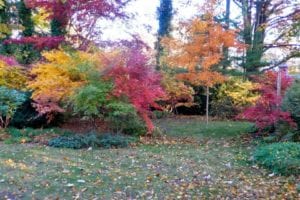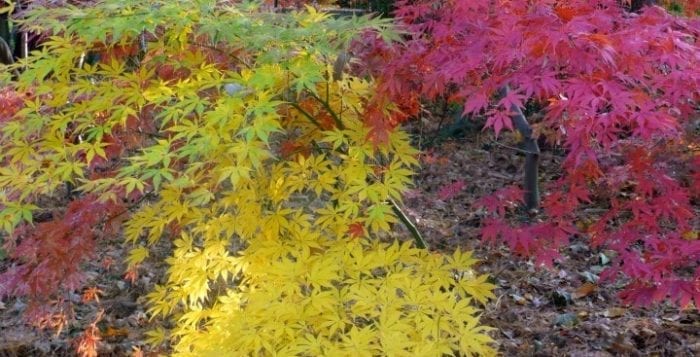By Kyrnan Harvey
“It’s fall, right?” my 7-year-old just asked. And I was like, “Um, yeah?” Notwithstanding a few weeks of unseasonably balmy, if not muggy, days, it is October and the first noticeable autumnal tints are seen in the American dogwoods that grow along the margins of the Laurel Ridge-Setauket Woods Nature Preserve on Belle Mead Road.
You needn’t be a gardener — nor ferry up to New England — to enjoy the weeks of glorious colors in the maples and the oaks in random woods and suburban roads: the yellow Norway maple, the red-orange of sugar and red maples, the russet-reds of the oaks.
There are many kinds of shrubs too, of course, that present fall color. These typically color up best in sunnier locations, but the native spicebush (Lindera benzoin), ubiquitous in our woods because the deer leave them alone, are beginning to yellow even in heavy shade. Last Saturday I was driving on Mt. Grey and West Meadow roads in Old Field, where homes are nestled into our native oak woods. Naturalized in the understory are the native mountain laurel, Kalmia latifolia, and planted rhododendrons that had grown massive before the deer population exploded.
If you live under a high canopy of oak trees, but want some great fall color, Japanese maples are a superb understory tree: They prefer some shade and will color up well despite it. Japanese maples are not limited to the popular weeping lacy trees. They are primarily Acer palmatum, but they also refer to Acer japonicum and Acer shirasawanum.

The grafted cut-leaf Japanese maple is justifiably popular but not inexpensive. These are propagated vegetatively, i.e., not by seed; they are called cultivated varieties (cultivars, in the trade), meaning they have specific genes; and they are identical to one another in leaf shape, size and color and also in rate of growth and habit, by which is meant the shape of the crown, whether pyramidal, weeping or columnar.
The spectacular cut-leaf Japanese maple (Acer palmatum var. dissectum), red-leafed or green, is better used singly, as a specimen. Mature tress will get to be 15 feet in diameter, so do not make the common mistake of planting it too close to your driveway or front path or up close to your house. It is always a shame to have to restrict with pruning the natural form of these.
If you have the opportunity to plant a grove of Japanese maples, maybe for screening or to start a woodland garden, then the most expedient way would be to find a source of random Acer palmatum seedlings. Young trees, cheap. Don’t overly favor the showy red-leaved ones; select if you can a mix of green and red. In Joe’s garden, a client, there were three or four mature Japanese maples. We had many dozens of seedlings, offspring from the mother trees, growing out of the compost of years of leaf-blowing.
Many years ago Joe and I potted up a few of the younger ones, from 3 to 7 years old, and on a sunny Saturday morning in late October loaded them into the 8-foot bed of my ’68 Chevy. We parked on 5th Avenue in Park Slope in Brooklyn and presented a sidewalk sale. They were gorgeous in their variety of fall reds, oranges and even yellows. Fifteen years later and there are many dozens more seedlings, I just can’t bring myself to pull them up and throw them in the compost pile.
True, the deer will nip them as long as they can reach the branches. It is worth the effort to spritz a little deer repellent, especially in April, May, and June, for the first couple years until the branches are up and out of their reach. There is a blight on them, a soil-borne fungus called Verticillium wilt, that causes branches to die. Cut them back to the trunk. Sometimes the whole tree dies. If you have a dozen or more trees, as I recommend, and they are seeding themselves around, then it’s easy-come-easy-go. You don’t have to mourn the loss of a tree if there are many more healthy ones about.
It’s okay to start with unnamed seedlings of Acer palmatum. They are always gorgeous, leafing out in spring with their iconic leaves, or changing color in fall, they are never out of scale in the garden and comport well with companion shrubs and perennials. You could order a dozen and supplement them with a few choice named cultivars that you gradually collect at the garden center or through mail-order sources; or you could start right off with the choice varieties.
It would be preferable to have some of these splendid cultivars because some of their offspring seedlings will carry their desirable traits. Japanese maples are prolific self-sowers, so you might want to plant two or three of the great, well-known varieties: Invest in a few large trees, sourced at a nursery. Have them planted in locations that establish the structure and articulate the paths of a new woodland garden, underplant them with perennials and start looking out for seedlings next year!
Kyrnan Harvey is a horticulturist and garden designer residing in East Setauket. For more information, visit www.boskygarden.com.





